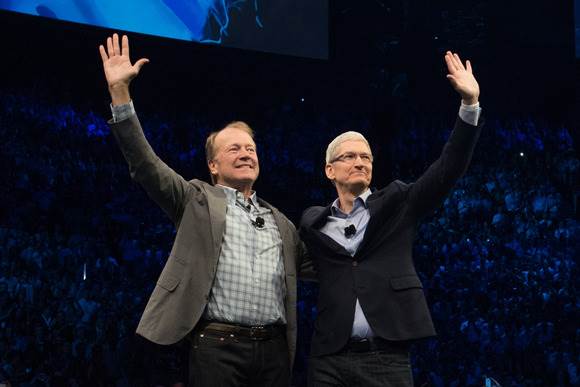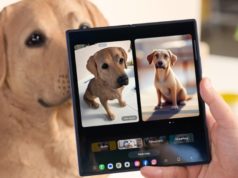Apple devices get some special capabilities on Cisco networks starting with iOS 10

Cisco Executive Chairman John Chambers, left, and Apple CEO Tim Cook at Cisco’s Global Sales Experience Conference in Las Vegas, where they announced a mobile enterprise partnership on Monday, Aug. 31, 2015.
Credit:
Cisco Systems
Favored status for Apple iPhones and iPads on Cisco Systems networks starts Tuesday, giving users better Wi-Fi roaming, integrated VoIP calls and priority for the most important business apps.
The benefits that the two companies envisioned more than a year ago start to come to fruition with iOS 10, which comes out Tuesday. They are designed to give the Apple devices enhanced capabilities on Cisco enterprise networks. The deal is a recognition that mobile devices have become primary tools for many workers.
The companies are rolling out several features on Tuesday. They’re available now to customers that upgrade to iOS 10 on devices and AireOS WLC 8.3 software on wirelss LANs. By the end of October, all current Cisco and Meraki WLANs will have the features.
Here are five new capabilities that may prove most useful.
1. Better Wi-Fi: Apple devices and Cisco networks will recognize each other so iPhones and iPads can roam more quickly and smoothly, said Jeff Reed, senior vice president of enterprise networking at Cisco.
When a user on an iOS device starts to leave the coverage area of one access point, a Cisco AP will provide a list of the top six nearby APs so the phone or tablet doesn’t have to go through dozens of them trying to find the best one to roam onto.
2. Smoother Wi-Fi security: iOS 10 devices can use IEEE 802.11r, a Wi-Fi security protocol that many devices don’t yet support. It’s been hard for enterprises to implement 11r because they had to set up one SSID for devices that can use the protocol and another for devices that can’t, Reed said.
Cisco WLANs can use just one SSID and dynamically jump into action and carry out the the 11r security handshake with iOS 10 devices that use 11r.
3. Priority for business apps: Enterprises with Cisco networks can choose the iOS apps they think are most important and give them an edge over others. For example, a corporate videoconference could get priority over a Facebook video so that if there’s congestion in the network, the Facebook video will suffer first. Cisco has let IT departments do this before but is now extending the capability to the wireless “last mile” between an access point and a mobile device.
4. Spark calls, regular phone experience: Employees can use the iPhone’s native phone interface while making and receiving VoIP (voice over Internet Protocol) calls with Cisco’s cloud-based Spark collaboration app.
Incoming calls to the user’s enterprise number will use Spark automatically but look like regular calls. Calls inside the enterprise can use Spark automatically, and when users make outside calls, they can choose to use Spark like they choose Facetime on any iPhone. Similar capabilities are coming later to Jabber, Cisco’s on-premises collaboration platform.
This is made possible through Apple’s new CallKit API, which isn’t specific to the partnership, but Cisco thinks it will be the first company to use CallKit.
5. iPhone calling, corporate logs: Because iPhone calls on Spark go over the corporate network as packets, employees can make calls as normal without racking up corporate cellular bills. Meanwhile, the company can log those calls for management and compliance purposes, which isn’t possible in the same way with cellular.






![[CES 2026] Quest For Perfect Color…Samsung To Push](https://loginby.com/itnews/wp-content/uploads/2025/12/CES-2026-Quest-For-Perfect-Color…Samsung-To-Push-100x75.jpg)
